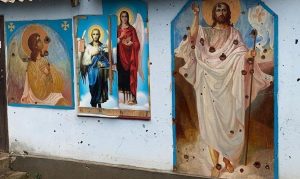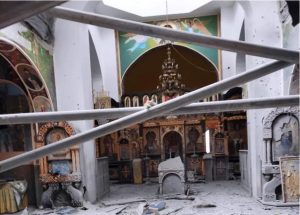
Michelle Coleman is a lecturer in law at Swansea University.
The war in Ukraine is possibly the most documented war in history. Governments, news organizations, the International Criminal Court, NGOs, and individuals are continually monitoring and documenting events as they take place in real time. Some of this collection and preservation of information is with an eye toward determining whether war crimes and crimes against humanity have been committed.
In March 2022 I wrote for this blog about the importance of information collection before deciding whether international criminal law would be pertinent to the war in Ukraine. I argued that the need for prosecutions and trials can only be determined following a thorough investigation. Some time must pass while a conflict is ongoing in order to gain perspective, gather evidence, and sort through what might be a war crime or crime against humanity and what might just be an unfortunate, but legal, consequence of war. Now, nearly a year later, we can consider the importance of this information gathering and how it may be used within the context of international criminal law.
The information being collected may or may not be evidence of international crimes. The net must be cast widely to preserve relevant information, which also helps set the historical record of the war and preserves and memorializes the culture, people, and places affected by the war. It is important to note that the immense quantity of information collected has not been fully analyzed; the investigations, like the war itself, are still ongoing. While a lot of information is available, we do not have an entirely clear picture of what that information shows. However, examination of evidence thus far has allowed for patterns to emerge, perhaps earlier than they would have otherwise, which support the idea that some international crimes have been or are being committed.
NGOs and other groups are very much at the heart of monitoring and information gathering. They frequently observe actions of governments and other groups to track human rights and watch for abuses. Within the context of Ukraine, NGOs have continued to monitor areas of their particular interests, which has helped sort the information and provided context and focus to specific areas where there may be cause for concern. An example of this can be found in two recent NGO reports focusing on the destruction of religious property and victimization of religious leaders and believers during the war in Ukraine. They show that there has been extensive damage to religious buildings across Ukraine without regard for affiliation and that some religious leaders and believers have been captured or killed. These reports may or may not provide evidence of criminality on the basis of religion.
Religious Leaders as Victims and Damage to Religious Buildings and Artifacts
The Institute for Religious Freedom (IRF), based in Kyiv, released a report on 15 July 2022. The IRF was uniquely positioned to start data collection from the early days of the invasion and has since gathered evidence and monitored the situation using open-source data. Its researchers have also surveyed leaders and official representatives of churches and religious associations. Using this evidence, they have documented attacks and recorded eyewitness testimonies in several regions of Ukraine.
The report found that the war has impacted at least 20 different religious denominations, including Orthodox, Catholic, and Protestant Christians; Jewish and Muslim associations; and many other religious and ethnic minorities. IRF research found that religious leaders are being tortured and killed, at least 270 religious buildings have been damaged or destroyed and looted, and Russian authorities are trying to take control of all religious activity within Ukraine as a method of subjugation. The IRF report alleges that missile strikes and artillery fire have been widespread and targeted at civilian infrastructure, including religious sites.

The second report, Religion on Fire, is a project resulting from a collaboration of several government and civil society groups that are engaged in an ongoing project in collecting evidence, conducting field visits, and monitoring damage to religious buildings. The project maintains a database of damage to religious buildings and harm to religious leaders and believers resulting from the war. The report, which details some of the information already gathered, describes evidence of widespread and indiscriminate shelling by Russian forces that has damaged or destroyed 251 religious buildings. It also suggests that religious buildings were specifically targeted for attack and that some were destroyed while being used as civilian shelter. Further, the report shows that many religious figures have died or been abducted.
Evidence of War Crimes?
The purpose of both reports is to document the damage done to religious buildings and attacks against religious leaders and believers during the conflict and to capture and preserve relevant evidence for future use. The evidence contained therein can be put to a number of different purposes, including being used in any future trials resulting from the war.
The reports themselves suggest that the damage done to religious buildings is evidence of war crimes. In fact, the reports may contain evidence that war crimes or crimes against humanity have occurred within this conflict, but to determine this, the information will need to be evaluated by international criminal investigators. Engaging in war is not necessarily a crime.
Further, humanitarian law allows and acknowledges that some civilian buildings and people are likely to be casualties of war without a crime being committed. War crimes or crimes against humanity generally require events to extend beyond expected casualties of war. War crimes require a showing of either (1) the specific targeting of civilians or civilian buildings by one of the groups fighting the war or (2) indiscriminate targeting of an area without regard to whether civilians or civilian buildings are within that zone. The destruction of religious buildings could be a war crime or crime against humanity as part of targeted or indiscriminate destruction of civilian buildings. Alternatively, if it can be proved that buildings were specifically targeted because of their religious status or cultural importance, their destruction may be evidence of crimes of religious persecution or destruction of cultural heritage. However, whether something is a violation of international criminal law can only be determined through a trial.

There are many challenges to evidence collection in conflict situations. For example, contemporaneous evidence collection might be very dangerous or impossible in areas where conflict is ongoing. Further, as I mentioned in my previous post, there is no international police or investigative force charged with investigating international crimes, so courts must rely on victims’ accounts and local groups and governments to find and provide the required evidence. These challenges can result in evidence being destroyed or lost before it can be found, preserved, and admitted to trial.
In light of these difficulties, international criminal law allows for evidence from more diverse sources than domestic criminal law. The collected evidence can then be used in a number of ways. This helps ensure that courts receive a full view of what happened in order to hold fair trials and determine whether criminal accountability is appropriate in a particular situation.
How Can the Information Be Used?
NGO reports can be used as evidence of international crimes. The International Criminal Court, for example, allows NGO reports to be admitted into evidence so long as they are relevant and otherwise comply with the Court’s Rules of Procedure and Evidence. However, NGO reports draw their own conclusions and rely on their own data. This creates concerns about bias, which can limit the evidentiary value of those reports during trial. Rather than being admitted as new evidence of events, NGO reports are more likely to be used in the limited role of corroborating evidence emanating from other sources. Examples of this can be seen in the Bemba trial at the International Criminal Court. During this trial eyewitnesses testified about seeing soldiers taking property from civilian homes. Some NGO reports which contained information about looting in Bangui were used to support and confirm the eyewitness testimony. The reports would not have been admissible without the eyewitness testimony and could only be used to support that testimony.
The greater value of NGO reports may lie in the data that support their findings. That underlying data can help investigators discover new evidence that could be more widely admitted at trial. For example, a report that identifies and locates religious buildings destroyed during the war might encourage trial investigators to investigate possible crimes being committed in areas that would otherwise have escaped their notice. Further, interviews contained in NGO reports could also lead to the identification of potential trial witnesses, who, without the attention drawn to them by the reports, might not have the opportunity to tell their story.
Notably, both the IRF and Religion on Fire reports relied on open-source data as part of their evidence. Open-source evidence is publicly available evidence that can be gathered through various online outlets including social media. This type of evidence has not yet become a common source of evidence in international trials because of authenticity and reliability concerns. Governments, the UN, NGOs, officials at the International Criminal Court, and other groups, however, are setting standards to ensure that this kind of evidence can be gathered, stored, and authenticated so as to be reliable for use in court. The identification, gathering, and storage of open-source data by NGOs and other groups could be useful to the Court should that type of evidence become usable or admissible in criminal investigations and trials.
Conclusion
Unfortunately, after a year of conflict it is difficult to see the end of the war in Ukraine. However, during the entirety of that time, numerous organizations have been diligently gathering information and documenting the events of the war. While some of this data might be evidence that war crimes or crimes against humanity have been committed, the information collected might also help preserve the historical record of events. Criminal accountability can only be determined through a trial, which is still some time off; however, NGOs and individuals are playing an important role in collecting and preserving evidence for such future trials.
